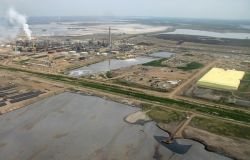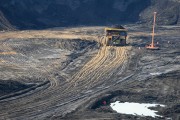The clock is ticking for the U.S. State Department to evaluate the proposed Keystone XL (KXL) pipeline. The federal agency is holding its final public hearings over the next few weeks to solicit one last round of comments before entering a 90-day decision period, during which it must determine if a pipeline from the oilsands to Texas is in the United States' best national interest.
While the State Department ideally wants everything wrapped up before the end of the year, it's a tight timeline for the Obama administration to make such an important decision.
Although the State Department did just release its Final Environmental Impact Statement (FEIS) for KXL, it understated some of the most important considerations, including alternate routing, project alternatives and environmental justice, to name a few.
And two of the most significant issues left out of the State Department's final impact statement are far too fundamental to simply overlook — upstream environmental impacts and climate change implications — and so we've pulled together briefing materials on these two key issues.
Upstream environmental impacts
The State Department is not required to consider the environmental impacts that occur in Canada from additional oilsands development required to fill the KXL pipeline. However, the agency notes in the FEIS that:
"[As] a matter of policy, and in response to concerns that the proposed Project would contribute to certain continental scale environmental impacts, [the U.S. State Department] has included a summary of information regarding environmental analyses and regulations related to the Canadian portion of the proposed Keystone XL Project in Canada..."
Unfortunately, the summary that follows in the FEIS (Section 3.14.4.3, page 3.14-61) reads more like promotional materials from the energy industry or Alberta government rather than a critical and sober analysis of oilsands environmental impacts and management.
The prestigious Royal Society of Canada (our version of the U.S. National Academy of Sciences) released a report on the oilsands last December that states:
"The current visibility of relevant provincial and federal agencies, in particular in dealing with the major environmental challenges [of Canada's oilsands] is low, and is generally not in line with those challenges."
The U.S. State Department apparently has a different understanding about Canada's ability to manage the oilsands.
 In response to the FEIS, the Pembina Institute has just released a fact sheet and more in-depth briefing note that outline current environmental management practices in the oilsands. Our analysis clearly demonstrates that there are considerable shortcomings in the existing oilsands environmental management framework.
In response to the FEIS, the Pembina Institute has just released a fact sheet and more in-depth briefing note that outline current environmental management practices in the oilsands. Our analysis clearly demonstrates that there are considerable shortcomings in the existing oilsands environmental management framework.
For instance, the recently released draft recovery strategy for woodland caribou allows for 95 per cent of caribou habitat in northeastern Alberta to be lost to oilsands development. Rather than preserve core habitat or moderate oilsands growth, the federal environment agency is advocating for the killing thousands of wolves to prevent caribou from going locally extinct.
Given these shortcomings, it is critical for U.S. decision-makers to think outside the pipe and reconsider the environmental impacts created in Canada from filling the proposed KXL pipeline.
Climate change implications
U.S. decision-makers should be particularly concerned with the greenhouse gas emissions associated with the proposed KXL pipeline. Unfortunately, the FEIS failed to adequately describe Canada's ability to manage greenhouse gas emissions from the oilsands. To provide additional context around what KXL-accelerated oilsands development means to greenhouse gas management in Canada, the Pembina Institute has produced a fact sheet and detailed briefing note.
Our analysis indicates the oilsands are clearly standing in the way of effective climate action in Canada.
"More than 99 per cent of all oilsands exported from Canada goes to the United States... one cannot overestimate the influence that decision making in D.C. has on decision making in Edmonton and Ottawa."
Existing climate policies at both the provincial and federal level are too weak to limit emission growth from oilsands. For instance, current carbon pricing in Alberta is too low to make carbon capture and storage economically viable in the absence of massive public subsidization and generous carbon offset revenue schemes. Federal Environment Minister Peter Kent had promised regulations for oilsands greenhouse gas emissions by the end of 2011, but has recently said that these regulations will be delayed. Moreover, a recent Pembina Institute analysis shows Canada will have to increase its greenhouse gas reduction efforts tenfold if it intends to curb the growth in oilsands emissions and reach its 2020 target.
Any oilsands emission intensity improvements are not guaranteed, and are virtually certain to be outweighed by the rapid increase in absolute emissions resulting from future oilsands expansion.
Keystone XL would hasten oilsands expansion and therefore increase the rate of emissions growth. This is particularly problematic given the ineffective greenhouse gas management currently in Canada and the Obama's Administration's goal of a clean energy economy.
The U.S. is Canada's only oilsands customer
More than 99 per cent of all oilsands exported from Canada goes to the United States. As a result, the U.S. has considerable influence over the environmental management of the oilsands and the climate change implications of the oilsands it imports. Simply put, one cannot overestimate the influence that decision making in D.C. has on decision making in Edmonton and Ottawa.
The United States has the ability to exert significant pressure on Canadian governments to improve environmental performance in the oilsands. For example, the U.S. could send a clear signal that the high-level of greenhouse gas emissions that result from current oilsands development practices are unacceptable, either by not approving further oilsands pipelines or by implementing progressive climate legislation that puts high-carbon fuel sources at a disadvantage.
Thinking outside the pipeline
When considering if the proposed Keystone XL pipeline is in America's national interest, the U.S. State Department should adopt a more rigorous analysis than simply echoing the impact-minimizing descriptions provided by the Government of Alberta.
It's time for U.S. decision-makers to think outside the pipeline — to consider the broader environmental implications of approving Keystone XL and to address just how this pipeline fits into President Obama's vision of a clean energy economy.







